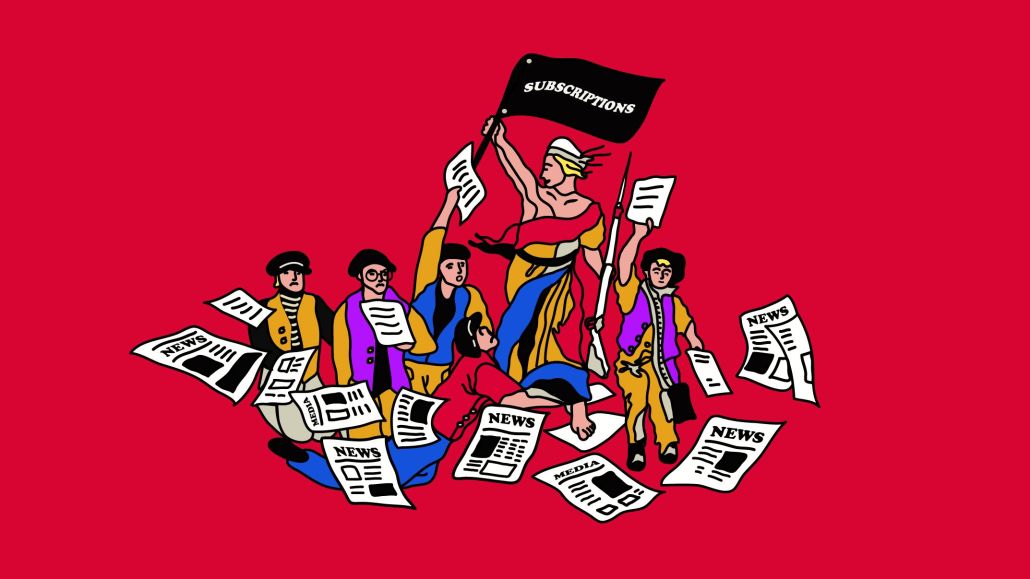
Business publisher Quartz has joined the likes of Vox and The Guardian in moving to a membership model, backed by the belief that readers will want to support the missions and journalism of the respective publishers enough to pay them without the pressure of a paywall. And Vice News plans to add a tip jar to gather reader donations this year. But can publishers still grow direct reader revenue without a paywall?
The Guardian’s business model — introduced in 2016 — was “an inspiration” to Quartz’s changes, said Quartz CEO Zach Seward. Quartz has gained 25,000 paying members since it put up its paywall in 2019 (and dropped that paywall to give free access to most of its content while shifting to asking readers to become paying members on April 14). The publisher also brings in advertising revenue, though a spokesperson declined to share revenue figures. Seward said there won’t be any immediate changes to the company’s advertising offerings as a result of the removal of Quartz’s paywall.
There’s proof that a membership model can work to bring in direct revenue from readers, which is especially helpful when publishers are hit by shifts in the advertising market. Vox, which launched its contribution program in the spring of 2020 “to mitigate the pandemic’s impact on the advertising business,” has grown its total number of contributors by 40% from March 2021 to March 2022, according to Blair Hickman, executive director of audience strategy at Vox, who declined to say how many unique contributors Vox has or how much those donations amounted to.
“It has become clear this has the potential to scale up and become a meaningful part of our business,” Hickman said. Most of Vox’s revenue, however, still comes from advertising.
The Guardian has more than a million digital subscribers and contributors (who have signed up for recurring payments), with more than half coming from outside the U.K., a spokesperson told Digiday. The company has grown revenue from digital subscribers and contributors by 87% in three years. Last summer, the Guardian announced digital reader revenue grew to £68.7 million (roughly $88.2 million) — a 61% increase year over year. In the next few months, the Guardian will begin testing a metered version of its app.
While publishers like The New York Times have found metered paywalls to be effective at driving subscribers, they can be “blunt force instruments” that may not work for all publishers, said Justin Eisenband, a managing director in FTI Consulting’s telecom, media & technology industry group.
An alternative is for a publisher to offer paying members premium content, such as subscriber-only newsletters, he said. And that’s just what Quartz is doing: paying members will also get exclusive access to additional benefits from Quartz, such as member-only email newsletters, including The Forecast and Weekend Brief. Its geographic memberships, including Quartz Africa (which launched in February) and Quartz Japan, will remain separate subscription products.
Last year, Quartz was seeing “plenty” of new members convert simply to read an article they searched for specifically, but then quickly unsubscribed. “This became a distraction from where we see the real growth, and that’s in the Quartz loyal membership and the more vertically-oriented subscriptions. We don’t want to be dealing with the one-and-done subscribers,” Seward said.
Instead, Quartz would be “better off” serving them an ad or getting them to become an email subscriber to start the journey of converting them to a paying member down the line, he said. More than half of Quartz’s existing paying members have been doing so for two years.
Eisenband also didn’t imagine there would be a significant increase in churn with this announcement. “If they know the reason their subscribers want to subscribe is because they want to support the mission of Quartz and the journalism, then I would imagine the likelihood of churn is relatively low,” he said. Quartz may be calculating it can “significantly increase advertising revenue without slowing down” the growth of new subscribers and be in a “better-off place by growing advertising revenue without impacting the subscription revenue in a meaningful way.”
To be clear, Quartz is encouraging people to pay up. Beyond the aforementioned member-only newsletters, the publisher also offered a 50% discount on its membership — which costs $14.99 a month or $99.99 a year — in an email sent to registered readers announcing the paywall change.
But as with other publishers such as The Daily Beast and The Atlantic, Quartz is adopting the approach of warming up its potential paying members to first become registered users. Readers are now served an email registration prompt when they read a second Quartz story, which they can dismiss. A hard email registration is served on their fourth visit.
“By far, the most successful and important customer journey for us is from free reader to free email subscriber to paying member. If someone is going to convert, it takes about four months to go from Daily Brief reader to becoming a member. That’s the customer journey and the marketing funnel that has been the most successful to date and that we want to focus on as much as possible,” Seward said.
More in Media

Here are the biggest moments in AI for publishers in 2025
Here are some of the moments that defined how publishers adapted to the AI era this year.

Digiday+ Research roundup: Gen Z news consumption and diversification in the DSP space were 2025’s top trends
As 2025 winds down, we rounded up the biggest trends of the year, based on the data that resonated the most with Digiday’s readers.

What publishers are wishing for this holiday season: End AI scraping and determine AI-powered audience value
Publishers want a fair, structured, regulated AI environment and they also want to define what the next decade of audience metrics looks like.








